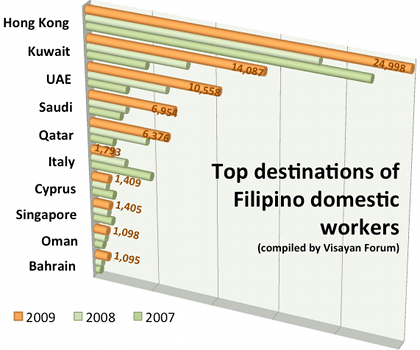SUMMARY
This is AI generated summarization, which may have errors. For context, always refer to the full article.

MANILA, Philippines – Filipino lawmakers are hoping to see a 15-year effort to guarantee the rights and benefits of kasambahays or household workers finally sealed into law this year.
Based on data compiled by the Visayas Forum, a non-government organization, below are some facts and figures on domestic help employed in the Philippines and elsewhere:
1. Domestic help defined
The Labor Code of the Philippines defines “domestic or household service” as a “service in the employer’s home” that provides convenience and personal comfort to the employer.
Domestic helpers include maids, cooks, yayas (nannies) drivers and all-around helpers.
Most domestic helpers have multiple duties that include cleaning, laundry, ironing, grocery shopping, cooking, taking care of the children, and driving the members of the household.
2. Statistics
Rough estimates of the number of domestic workers in the Philippines range from roughly 600,000 to 2.5 million.
Official data based on the July 2010 Labor Force Survey estimate that there are over 1.8 million private households with employed persons.
According to the Philippine Child Labor Survey, nearly 600,000 child laborers aged 5 to 14 years old are in the service industry and that 373,000 children work in private households.
3. Compensation
In the Philippines, the current monthly minimum wage for domestic helpers is
- P800 (est. US$18.4 or 14.8 euros) in Metro Manila and highly urbanized cities
- P650 (est. US$15 or 12 euros) in other chartered cities and first class municipalities
- P500 (est. US$11.5 or 9.25 euros) for those in other municipalities
Average daily pay is P89 (est. US$2.05 or 1.6 euros) nationwide. Private households in National Capital Region (NCR) pay an average of P111.84 a day. Those in Zamboanga Peninsula pay the most with P122.80 a day.
Under the Labor Code, live-in domestic helpers are also entitled to lodging, food, and medical assistance.
Helpers earning over P1,000 per month must be enrolled in the social security system.
3. Place of employment
About 35% of local domestic helpers are found in the National Capital Region.
The other top domestic helper employers are in the following regions: Calabarzon (12.1%), Central Visayas (9.8%) and Western Visayas (7.3%).
4. Top sources
Most domestic workers in the Phiippines are likely to be from the Visayas regions, Bicol, Southern Tagalog and Northern Mindanao.
Local domestic helpers were recruited primarily through informal methods, including word-of-mouth and referrals.
5. Overseas workers
Overseas domestic workers, mostly female laborers and unskilled, are among the top remitters. They sent home P13 billion in 2007.
One of 3 Filipinos deployed overseas from April to September 2007 were laborers and unskilled workers which include domestic helpers, cleaners and manufacturing laborers. In 2009, over 71,000 Filipinos newly hired as household service workers overseas.
Most are from the National Capital region, Southern Tagalog, Ilocos, Cagayan Valley, Central Luzon, Soccsksargen and Western Visayas.
In 2009, the top 5 countries of destination of newly hired household service workers were Hong Kong, Kuwait, United Arab Emirates, Saudi Arabia and Qatar.

6. Violations and abuses
Both local and overseas domestic workers face common problems: long working hours with no rest periods, non-payment of wages, verbal, physical and sexual abuse and a lack of adequate accommodation.
Child and adult domestic workers lack access to education, and are vulnerable to illegal recruitment, force labor, debt bondage and human trafficking.
Visayan Forum said that they have assisted 510 abused domestic workers per year since 2001. Almost 98% of complainants are female. Usual abuses are physical, verbal, and sexual in nature. Huge number of these cases also involved non-payment of wages and social security.
Trafficking cases related with domestic work usually involve those bound for Malaysia, Singapore, and Middle East countries. – Rappler.com
Click on the links below for related stories.
Add a comment
How does this make you feel?
There are no comments yet. Add your comment to start the conversation.